
Speech Language and Hearing
Scope & Guideline
Exploring the nuances of speech and hearing innovation.
Introduction
Aims and Scopes
- Communication Disorders Research:
The journal publishes studies that investigate various communication disorders, including speech sound disorders, stuttering, and aphasia, aiming to enhance diagnostic and therapeutic approaches. - Innovative Therapeutic Approaches:
Research on new therapeutic interventions, including telepractice and technology-assisted therapy, is a core focus, reflecting the journal's commitment to advancing clinical practices in speech-language pathology. - Cultural and Linguistic Diversity:
The journal emphasizes research that addresses the needs of culturally and linguistically diverse populations, ensuring that interventions are relevant and effective across different communities. - Interdisciplinary Collaboration:
The journal promotes collaboration between speech-language pathologists and other healthcare professionals, highlighting the importance of a holistic approach to treatment and rehabilitation. - Educational Strategies and Training:
A focus on educational practices for future speech-language pathologists, including curriculum development and experiential learning, is evident, emphasizing the importance of preparing practitioners for real-world challenges.
Trending and Emerging
- Telehealth and Remote Interventions:
There is an increasing focus on telehealth and remote intervention strategies, particularly in response to the COVID-19 pandemic, emphasizing the need for accessible care in diverse settings. - Use of Technology in Therapy:
Research exploring the integration of technology, such as AI-based tools and natural language processing, into speech therapy is gaining momentum, reflecting a trend towards innovative, data-driven approaches. - Multilingualism and Bilingualism:
Emerging studies on the effects of bilingualism on communication disorders, especially in children, indicate a growing recognition of the complexities involved in language acquisition in multilingual contexts. - Parent and Caregiver Involvement:
The importance of involving parents and caregivers in therapy processes is increasingly highlighted, recognizing their critical role in supporting children's communication development. - Focus on Quality of Life and Holistic Outcomes:
Research assessing the broader impacts of communication disorders on quality of life, particularly among aging populations and individuals with co-occurring conditions, is becoming more prominent, indicating a shift towards holistic care.
Declining or Waning
- Traditional Speech Assessment Methods:
There is a noticeable decline in studies focusing on traditional speech assessment methods, as newer, more innovative approaches such as automated scoring and natural language processing gain traction. - Generalized Stuttering Research:
Research specifically addressing stuttering without considering co-occurring disorders or contextual factors has become less frequent, indicating a shift towards more nuanced explorations of the condition. - Static Models of Communication Disorders:
There appears to be a waning interest in static models of communication disorders, with a growing preference for dynamic, context-sensitive approaches that consider individual variability and environmental influences. - Single-Domain Studies:
The journal has seen a reduction in studies focusing exclusively on one aspect of communication disorders, such as purely phonological or auditory studies, as interdisciplinary and integrative research becomes more valued. - Epidemiological Studies without Intervention Focus:
Epidemiological research that does not link findings to practical interventions or clinical applications is decreasing, suggesting a shift towards research that has direct implications for practice.
Similar Journals

BRAIN AND LANGUAGE
Unraveling the Mysteries of Language and the BrainBRAIN AND LANGUAGE is a premier journal published by Academic Press Inc Elsevier Science, dedicated to fostering scholarly communication in the fields of Cognitive Neuroscience, Linguistics, Psychology, and Speech and Hearing. With its ISSN 0093-934X (Print) and 1090-2155 (Online), the journal has established a significant presence since its inception in 1974, continuing to provide valuable insights into the intricate relationship between brain function and language processing. This journal is highly regarded, boasting a 2023 ranking of Q1 in Linguistics and Language, reflecting its influential contributions to the field, alongside Q2 rankings in categories such as Cognitive Neuroscience and Experimental Psychology. With a rigorous peer-review process, it serves as an essential resource for researchers and professionals seeking to deepen their understanding of language mechanisms and their cognitive underpinnings. Despite not being an Open Access journal, BRAIN AND LANGUAGE ensures that its articles are widely accessible and of high quality, making it an indispensable platform for both emerging and established scholars aiming to expand the boundaries of research in language and cognition.
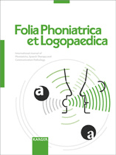
FOLIA PHONIATRICA ET LOGOPAEDICA
Bridging Theory and Practice in Phonetics and Speech TherapyFOLIA PHONIATRICA ET LOGOPAEDICA, published by KARGER in Switzerland, stands as a premier journal in the fields of linguistics, phonetics, and speech therapy. With a rich history beginning in 1949 and spanning multiple decades, this esteemed journal has maintained a commitment to advancing research and scholarship in communication sciences, covering crucial topics relevant to both clinical practice and theoretical frameworks. Holding a prestigious Q1 ranking in Linguistics and Language, the journal also achieves high standings in related categories, with notable placements in Speech and Hearing and Nursing. Researchers, professionals, and students will find the insights and findings published within its pages to be invaluable for both academic pursuits and practical applications. Access options are available through traditional subscription models, enhancing its accessibility for dedicated scholars seeking to contribute to or expand their knowledge in this dynamic field.
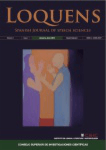
Loquens
Pioneering Research in Communication and LinguisticsLoquens is a leading academic journal dedicated to advancing the fields of Communication, Linguistics and Language, and Speech and Hearing. Published by the Consejo Superior Investigaciones Cientificas-CSIC in Spain, this journal has established a significant presence in the academic community since its inception in 2018, now spanning several impactful years of scholarly contribution. With its Q3 ranking in Communication and Q2 in Linguistics and Language as of 2023, Loquens serves as a vital platform for researchers and professionals to disseminate their findings and engage in critical discourse. The journal emphasizes the importance of open access to knowledge and provides readers with the opportunity to access its articles freely, fostering a collaborative environment for innovation and exploration in communication and language studies. Despite currently holding modest rankings in Scopus, with a percentile of 15th in Communication, Loquens continually strives to enhance its impact and visibility within the relevant disciplines. This commitment to scholarly excellence makes Loquens an essential resource for those passionate about exploring the complexities of human communication.
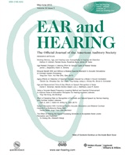
EAR AND HEARING
Pioneering research in hearing and balance.EAR AND HEARING, published by LIPPINCOTT WILLIAMS & WILKINS, is a premier journal dedicated to advancing the fields of Otorhinolaryngology and Speech and Hearing. With an ISSN of 0196-0202 and an E-ISSN of 1538-4667, this prestigious journal has established itself as a leading resource for researchers and clinicians alike since its inception in 1980. As of 2023, it proudly occupies Q1 quartile positions in both Otorhinolaryngology and Speech and Hearing, reflecting its influence and impact in the scientific community, further underscored by its exceptional Scopus rankings—#1 in Speech and Hearing and #9 in Otorhinolaryngology. Although it does not offer Open Access options, EAR AND HEARING remains an invaluable repository of cutting-edge research, reviews, and clinical insights that aim to enhance understanding and treatment of auditory and vestibular disorders. Its relevance is amplified by a comprehensive scope that encompasses innovative clinical practices and fundamental research, making it an essential read for researchers, professionals, and students dedicated to improving auditory health.
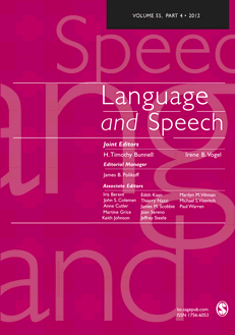
LANGUAGE AND SPEECH
Pioneering Research in the Heart of CommunicationLANGUAGE AND SPEECH, published by SAGE PUBLICATIONS LTD, is a premier journal that serves the multifaceted realms of linguistics, speech science, and sociology. With a robust history of scholarly contribution since 1958 and an anticipated continuation through to 2024, the journal is recognized for its high-impact research, boasting a commendable impact factor and achieving Q1 ranking in both Linguistics and Sociology as well as Q2 in Medicine and Speech and Hearing categories as of 2023. The journal, available in both print and online formats with ISSN 0023-8309 and E-ISSN 1756-6053, provides a vital platform for interdisciplinary discourse among researchers, professionals, and students alike. Its rigorous review process and quality publications place it at the forefront of academic inquiry, offering critical insights that advance the understanding of language and its implications in various contexts. As a key resource in the field, LANGUAGE AND SPEECH continues to foster innovation and knowledge dissemination, making it an essential addition to the libraries of those committed to exploring the depths of communication sciences.
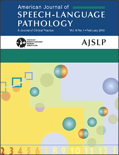
AMERICAN JOURNAL OF SPEECH-LANGUAGE PATHOLOGY
Advancing the Science of Communication and CareAMERICAN JOURNAL OF SPEECH-LANGUAGE PATHOLOGY is a premier publication in the fields of speech-language pathology, linguistics, and related health professions, published by the American Speech-Language-Hearing Association. With an impressive scope that encompasses research, clinical practice, and education, the journal aims to advance knowledge and practices in the diagnosis, treatment, and prevention of communication and swallowing disorders. It holds notable rankings in 2023, including Q2 in Developmental and Educational Psychology and Q1 across key categories such as Linguistics and Language, Medicine (Miscellaneous), Otorhinolaryngology, and Speech and Hearing, reflecting its significant impact and relevance in these domains. The journal’s robust methodology and peer-reviewed articles serve as an essential resource for researchers, practitioners, and students alike, fostering innovation and collaboration within the field. Published continuously since 1996, it provides a platform for disseminating groundbreaking research that influences clinical practices and educational strategies, enhancing the quality of care for individuals with speech and language challenges.

Communication Sciences and Disorders-CSD
Innovating practices in communication disorders since 2013.Communication Sciences and Disorders-CSD, published by the Korean Academy of Speech-Language Pathology & Audiology, is a pivotal academic journal dedicated to the fields of communication sciences, speech-language pathology, and audiology. With an ISSN of 2288-1328 and an E-ISSN of 2288-0917, this journal has been contributing to the body of knowledge since 2013 and is set to continue its impactful journey through 2024. The journal is recognized for its rigorous research and maintains respectable rankings within various categories, achieving a Q2 in Linguistics and Language and Q3 in Communication, Speech, and Hearing for 2023. It offers valuable insights for researchers and professionals committed to advancing understanding and treatment in communication disorders. Though currently not open access, the journal provides robust academic resources that are essential for those striving to innovate and enhance practices in speech and hearing disciplines in South Korea and beyond.
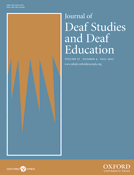
Journal of Deaf Studies and Deaf Education
Fostering dialogue in the realm of Deaf studies.The Journal of Deaf Studies and Deaf Education, published by Oxford University Press, is a leading scholarly resource that focuses on the multifaceted realm of deaf studies, encompassing linguistic, psychological, educational, and social dimensions related to deafness and hearing impairments. With an impactful presence in both the Education (Q2) and Speech and Hearing (Q2) categories, this journal serves as a critical platform for disseminating innovative research and fostering discourse among professionals, educators, and scholars from across the globe. The journal is indexed in high-reputation databases and ranks prominently within the Scopus rankings, indicating its relevance and influence in the fields of Health Professions and Social Sciences. Published quarterly, the journal facilitates comprehensive access to groundbreaking studies and theoretical advancements that aim to improve educational methodologies and outcomes for deaf and hard-of-hearing individuals. As it celebrates two decades of impactful publication from 2004 to 2024, the Journal of Deaf Studies and Deaf Education continues to champion the scholarly pursuits aimed at enhancing understanding and support for the deaf community.
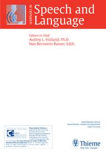
SEMINARS IN SPEECH AND LANGUAGE
Transforming the practice of communication disorders.SEMINARS IN SPEECH AND LANGUAGE, published by Thieme Medical Publishers Inc, is a distinguished journal established to advance the study and practice of speech and language pathology. Boasting ISSN 0734-0478 and E-ISSN 1098-9056, this journal has carved a niche in the fields of speech and hearing, and nursing, holding impressive ranks in the latest Scopus categorization. With an impact factor that reflects its growing influence, SEMINARS IN SPEECH AND LANGUAGE serves as a platform for the dissemination of cutting-edge research, clinical practices, and innovative therapies, aiming to support professionals, researchers, and students alike. It provides critical insights aimed at enhancing patient outcomes and driving forward the science of communication disorders. Covering the period from 1984 to 2024, this journal continues to thrive in its mission to foster collaboration and knowledge-sharing within the community.

Auditory and Vestibular Research
Unveiling Insights in OtorhinolaryngologyAuditory and Vestibular Research is an esteemed open-access journal published by Tehran University of Medical Sciences, dedicated to advancing the field of otorhinolaryngology and speech and hearing sciences. Established to foster scholarly communication, this journal has gained traction since its inception and has been openly accessible since 2015, encouraging a wider dissemination of research findings. With an E-ISSN of 2423-480X, it features a diverse range of studies and reviews that reflect the latest advancements and methodologies in auditory and vestibular functioning. As of 2023, the journal is ranked Q3 in both Otorhinolaryngology and Speech and Hearing categories, indicating a growing significance within the academic landscape, especially among researchers and healthcare professionals focusing on auditory health. By publishing quality research and facilitating dialogue within the community, Auditory and Vestibular Research plays a crucial role in informing practice and enhancing knowledge in these vital areas of medicine.